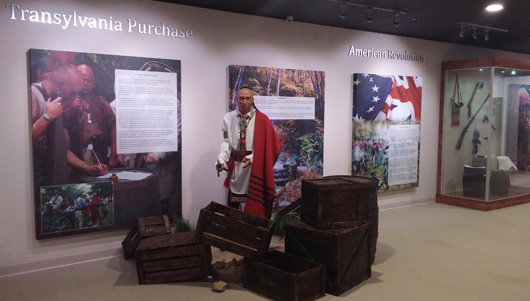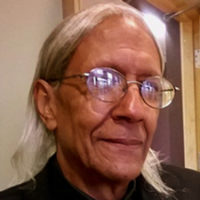
NASHVILLE, Tenn. – Native Americans and others from throughout the state commemorated the life of the great Cherokee war chief, Dragging Canoe, with a celebration February 27. It was well attended by both Indians and non-Indians. The event was entitled Dragging Canoe Day.
It was appropriate that the gathering was held in Nashville as the great leader fought many battles against settler encroachments in the area now covered by the city. In fact, on April 2, 1781, he led Cherokee forces that nearly wiped out Fort Nashborough, the first white settlement in Middle Tennessee, in the Battle of the Bluffs. The fort was sitting on Cherokee treaty land. The settlers sustained such heavy losses that many considered abandoning the area completely.
Dragging Canoe was born around 1732, when the Cherokee Nation was in the nascent stages of turmoil in a rapidly changing world. This period led into the crucible of the Cherokee wars beginning in 1760 and continued almost incessantly until the late 18th century (for tribes east of the Mississippi the 18th century is considered a period of one hundred years of constant warfare). He is noted in Euro-American history annals at the illegal Treaty of Sycamore Shoals in March of 1775, the purpose of which was for land speculators to defraud the Cherokee Nation of 20 million acres of land, including a large portion of present-day Kentucky and most of Middle Tennessee. The war chief quickly saw through their schemes and accurately predicted they would find settlement of the land to be “dark and bloody.”
The official Cherokee leadership later repudiated the so-called Sycamore Shoals Treaty and maintained that they thought an agreement was simply being made to permit the colonists to have limited grazing rights in certain parts of Kentucky. Further, they held that the trade goods which the speculators said bought the land in fact had been meant as indemnification for damages Cherokees had sustained from white ruffians attacking Cherokee border towns.
Early in the summer of 1776 tension escalated, with rumors abounding that the colonists were massing armies to destroy the Cherokee Nation. Dragging Canoe expressed sadness and anger when he said that the settlers had “surrounded us, leaving only a little spot of ground to stand upon, and it seems to be their intention to destroy us as a nation.”
Dragging Canoe, not waiting for the rumored attack, went on the offensive, and took the battle to the colonists. This was the beginning of the last long and bloody Cherokee War that lasted 18 years. The colonials responded with military force in the late summer and early fall, numbering in the thousands of soldiers, whose orders were: “The utter extirpation of the Cherokee Nation.” Their objective was the extermination of the Cherokee Nation. Historical records chronicle the wanton killing of non-combatants –women, children, and the elderly–with horrific barbarity: just about any Cherokee who fell into their hands was hideously murdered. Infants and small children had their brains bashed out by swinging them by their feet against trees, women were decapitated with broadswords and also bound and burned alive in groups in their homes. Atrocities were committed that by today’s standards would be war crimes.
But the Cherokee people rallied by their war chief, and fought the invaders tooth and nail. The Cherokee war companies met the invaders at the battles of Cowee Mountain, Twelve Mile Creek, the Black Hole, Esseneca, Nequassee Pass, Tomassee, Sugartown and Wayah Gap. Other battles large and small raged throughout Cherokee country. At night sentries were attacked and often killed or carried off by Cherokees in groups or by lone warriors. The flanks of the colonial armies were constantly haunted by the fire of Cherokee snipers. But, notwithstanding the incomparable valor of the Cherokee warrior companies, the country was ravaged and countless towns and villages were razed. (An interesting aspect of this struggle is that the tremendous Cherokee resistance during this period was largely ignored in books written in the 19th and 20th Century by Anglo American historians. Volume after volume contends that there was little or no resistance to the colonial armies when just the opposite was the case.)
Dragging Canoe, in the face of such devastation, refused to concede defeat, adhering to the age-old maxim: “retreat and fight on.” He advocated abandoning the ancient towns in upper east Tennessee and relocating to the region of the southeastern part of the state around present-day Chattanooga to continue the war against the genocide-bent white colonists. The majority of the Nation followed his lead and built new towns, giving them the same names of those they had left. This was a mass exodus of Cherokee people- thousands of warriors, women, children, the elderly, the entire populations of towns, irrespective of age or gender, determined to fight on regardless of consequences. This mass migration moved southwestward down the Tennessee River. (Also, most Anglo American historians of the “old school” contended that only a small number of Cherokee dissidents followed Dragging Canoe, when again just the opposite was the case.)
From this position, Dragging Canoe blockaded the entire expanse of the Tennessee River westward from any settler incursion. He utilized the military tactic of a “defense in depth” which meant that any force attempting to traverse the river would find defender/combatants increasing in mass with the passing of each warrior checkpoint. Sentries kept watch for invaders on the river 24 hours a day for over almost two decades.
He also commanded Cherokee war companies against encroaching white settlements all over the South and East, in particular settlers in upper east Tennessee, but also in Virginia, Kentucky, Indiana, Georgia and North and South Carolina. He continued to lead warriors against the Middle Tennessee settlements, which he kept in a virtual state of siege. His tactic in this instance was to conduct a war of attrition that would so weaken the colonial forces until the time was ripe for the fatal blow that would destroy all of the offending settlements. He planned, directed and led warrior forces in saving the Cherokee people from destruction.
Moreover, Dragging Canoe fostered numerous diplomatic efforts that brought other Indian nations, both north and south, into a war of resistance that virtually engulfed all of the country east of the Mississippi. He envisioned a vast Native confederacy that would stop colonial expansion. Warrior companies were exchanged with other tribes as a show of solidarity in the war. The celebrated Tecumseh, as a youth, fought under the leadership of the brilliant war chief.
Dragging Canoe is called by some 20th century historians “The Red Napoleon.” In pioneer days many white settlers, in dread and terror, just called him “The Dragon.” The great leader died undefeated. He is now considered by many historians to have been a military genius.
Dragging Canoe changed the course of history in that settler expansion was brought to a standstill in vast areas of the South and adjoining regions for an entire generation.
But “Dragging Canoe’s War” was a war to stop illegal, racist settler usurpation of Cherokee land, and moreover all Indian land and the wanton taking of innocent Native lives. If the invasion had ceased and the settlers stayed within the boundaries agreed upon under the treaties, there would have been no war. As historian Pat Alderman, who authored a biography of Dragging Canoe, so fittingly put it, the conflict was the result of “the insatiable lust of the whites for the red man’s land.”
Among the speakers at the event, Dragging Canoe Day, which this writer moderated, all stood out, but two in particular. One echoed the words of the war chief: “we are not conquered.” Another said: “It ain’t over.”
Dragging Canoe walked on from this world on or about March 1, 1792, and left a legacy that all American Indians can revere with pride. May we carry on his spirit in the struggle for the “cause” with the same courage, resolve and determination.
Photo: Dragging Canoe exhibit at Sycamore Shoals State Park. | Native History Association












Comments